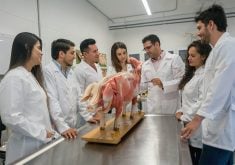The Saskatchewan Agricultural Health and Safety Network plans to twist some arms this year.
The network will celebrate its 20th year in 2008 and to mark the anniversary, it has announced a campaign to sign up 200 rural municipalities as members.
Right now 166 RMs are members of the network, out of a total of 298 RMs in the province.
The network started with five original members, founder Jim Dosman told the network’s annual meeting March 14.
RM councils pay $3.50 for every family in their tax area as a membership fee in the network, to a maximum of $1,000 a year.
Read Also

Fuel rebate rule change will affect taxes and AgriStability
The federal government recently announced updates to the fuel rebates that farmers have been receiving since 2019-20.
Last year, the network had a budget of $246,602 including RM fees and a grant from the Saskatchewan agriculture department.
In return, the network offers educational seminars about farm safety, lung and hearing testing and a newsletter.
The network also represents farmers through its connections to national health organizations and obtains funding from the federal and provincial government to carry out agricultural health and safety research.
Dosman, who is also director of the network’s parent organization, the Canadian Centre for Health and Safety in Agriculture, noted that a move forward is coming with a $5.8 million grant from a federal government agency to build a national laboratory for agricultural health research.
It will be part of an expansion of the University of Saskatchewan’s health sciences complex. He said the lab should be operational in four years.
One of the network’s most successful seminars has dealt with the issue of sleeplessness.
“It struck a chord with people,” said Christa Marcotte, chair of the network’s advisory committee and reeve of the RM of Cambria.
“My son is 16 and he loved it.”
Marcotte said 2,000 people from across Saskatchewan have attended one of the sleeplessness seminars.
Sleep specialist Jon Shearer from Algonquin College in Ottawa, who presents the information, says getting eight hours of sleep a night is unattainable for most people.
However, he also offers tips for how people can get a quality sleep, if not a long sleep, that relieves them of stress, fatigue and the potential risk of injury.
The network will publicize later this year the results of 1,600 surveys returned by farmers about farm stress. It is also comparing the safety record in RMs that are part of the network with those that aren’t.
Dosman said they don’t know what the findings will be because there are many factors that contribute to accident rates.
“It’s a combination of culture, economics and technology.”
The Saskatchewan network is unique in Canada. Dosman said that is because it is grassroots driven and involves local ownership of the program.
He noted support for the network’s projects is stronger among younger farm families.
Through the elected RM advisers, “we try to make our programs on the cutting edge” of farming changes.














